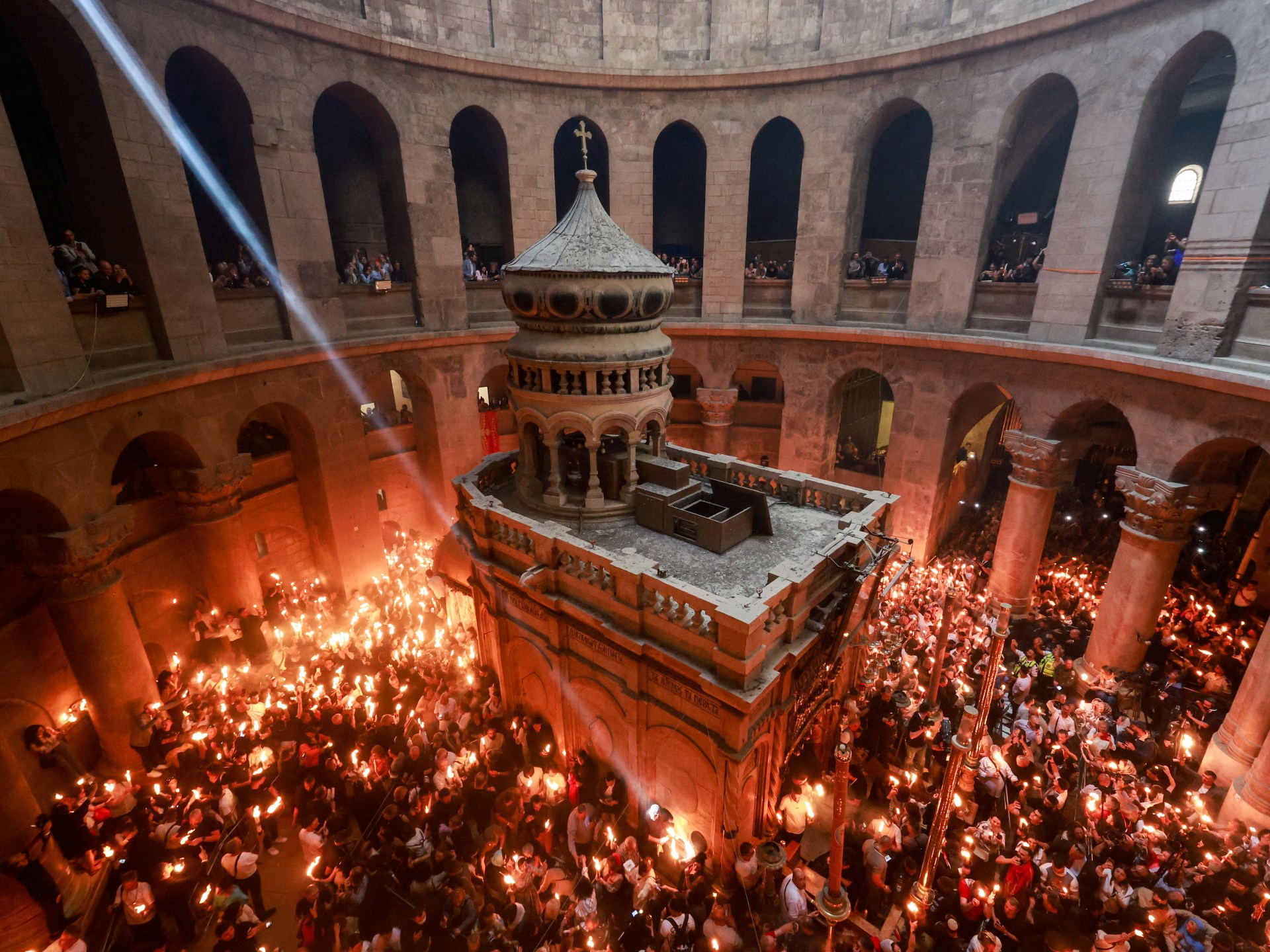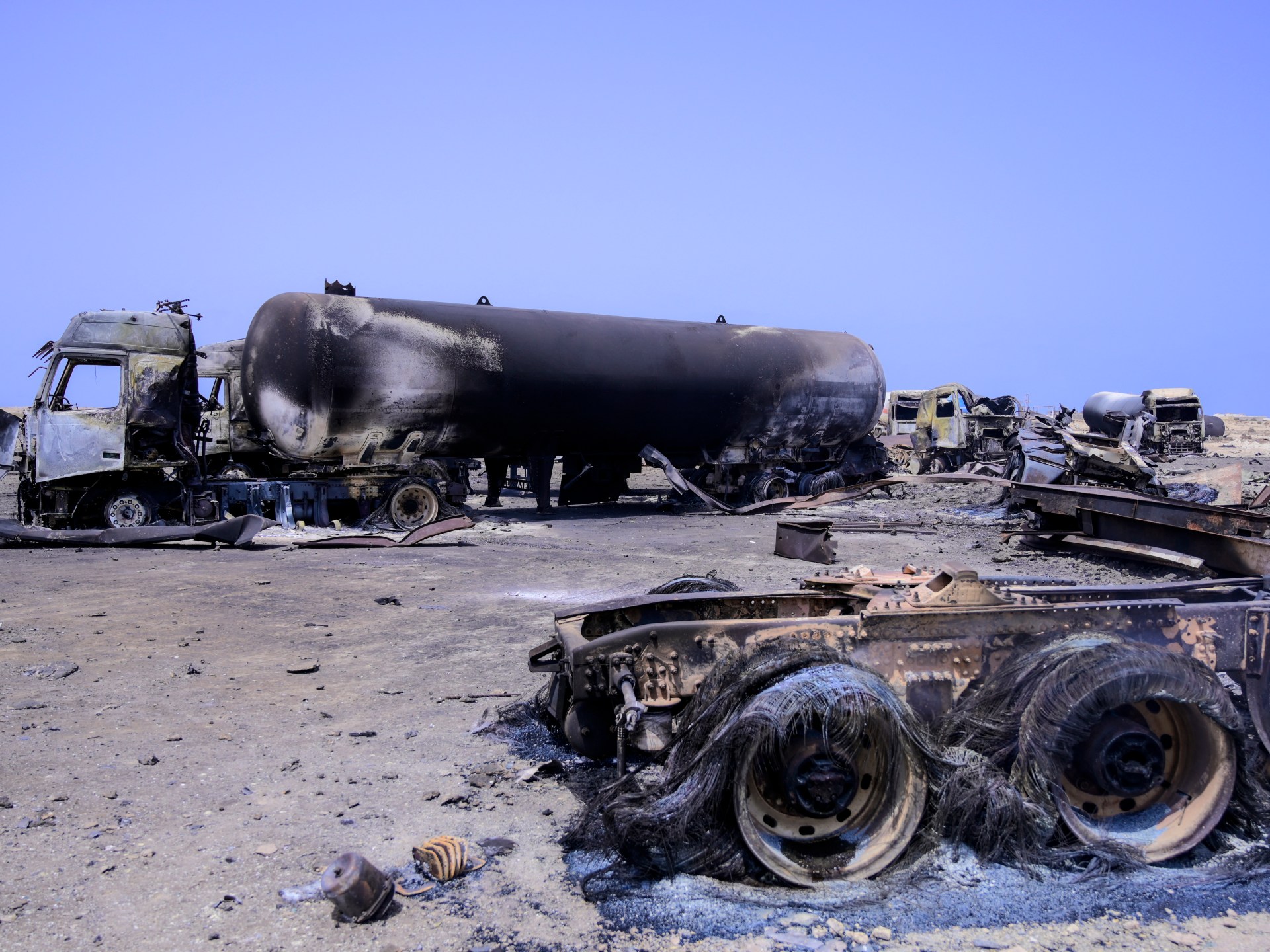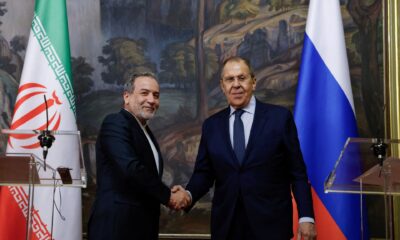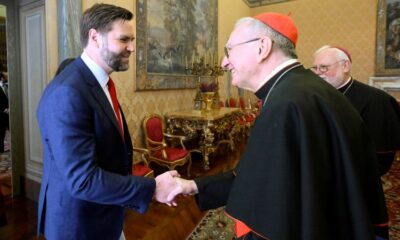Middle East
Trying to heal the trauma of Israeli raids in the occupied West Bank | Israel-Palestine conflict News

Jenin and Tulkarem, occupied West Bank – Omaima Faraj bows her head in silence for a moment – she’s tired, but the work does not stop.
She arrives at a school-turned-shelter near Tulkarem where her first patient, an elderly displaced woman who greets her tenderly, is waiting for her to measure her glucose and blood pressure. Then she moves to the next classroom, the next patient, walking down an open passage drenched in late-February sunshine.
Faraj, 25, has been volunteering to help residents devastated by the Israeli raids for weeks. She is one of the young Palestinians working to address the emergency Israel is creating across the occupied West Bank as it raids refugee camps and displaces thousands.
Rushing into danger
When Israel’s military occupation and displacement of the camp began in what the Israelis have called operation “Iron Wall”, on January 21, Faraj rushed into Tulkarem’s refugee camp instead of running away from the violence.

She stayed there with her fellow volunteers for more than 12 critical days when the attacks were at their fiercest and people were still trying to organise to flee the camp.
They focused on delivering aid to people in need – the injured, the elderly, and people with limited mobility. Nobody could get to a hospital because the Israeli soldiers wouldn’t let them.
Israeli soldiers harassed the volunteers, Faraj recounts, describing how they would threaten her and her colleagues, telling them to leave and never return or they’d be shot.
One incident particularly haunts her, of an elderly man who was trapped in his house for four days.
The team kept trying to reach him, but Israeli soldiers blocked their path. Finally, the International Committee of the Red Cross intervened, coordinating with the Israelis to allow safe passage for the volunteers.
When they reached the man, he was in dire straits – lacking food, water and hygiene for four days, but they were finally able to evacuate him.
As they were leaving, they were goaded, warned not to return – or risk being shot.
Backpack medics
“We didn’t have an emergency plan for this,” says Alaa Srouji, director of the Al-Awda Center in Tulkarem.

Al-Awda and the Lajee Center of Aida Camp in Bethlehem are training volunteers to document the expulsions of people and camp conditions so they can assess the aid needed.
The volunteers are about 15 mostly female nurses and medics who came together when the Israeli raids began, to provide medical aid and distribute essentials to the thousands who were harmed.
Their young faces show the toll of nearly two months of working nonstop with people displaced by the Israeli attack on the Nur Shams and Tulkarem camps.
They are struggling to fill a huge gap left when Israel banned the United Nations Palestinian refugee agency (UNRWA) from helping people in the occupied West Bank.
These volunteers don’t have headquarters, they spend all day walking around to serve people with nothing more than their backpacks and determination.
They go to one of the 11 temporary, hurriedly set up shelters or wherever their patients have managed to find a place to live.
They bring medical and psychological support and also clothes, food, and other necessities to those who have lost everything to Israel’s raiding soldiers.

In their backpacks are gauze, portable glucose monitors, gloves, bandages, tourniquets, manual blood pressure monitors, notebooks and pens.
“Our role as a local community is so important,” says Alaa.
The volunteers must also support each other emotionally, holding group sessions to cope with the toll of working within their devastated communities.
Many of them are from the camp, so they are also displaced, targeted, and have seen their neighbourhoods levelled by Israeli bulldozers.
Faraj is no different. Like many Palestinians, she is marked by loss and violence after her 18-year-old brother was killed by an Israeli drone in January 2024.
The camp is a no-go zone. Some displaced residents take the risk of returning to their homes to try to retrieve some of their belongings.
They navigate rubble-filled streets, the stench of rotting food left behind in now-abandoned houses, and sewers torn open by bulldozers, while Israeli soldiers patrol and drones hover overhead, searching for movement inside the camp.
Laughing, crying, screaming the trauma
An hour’s drive from Tulkarem is Jenin, and 10 minutes from Jenin is a village called Kafr Dan where an unusual sound filters in the air – children’s laughter.

About 20 children roam around the garden of a large house. They’re gathered into a rough circle by trainers who encourage them to speak – loudly – to let out their fear and anger.
The activity is organised by the Freedom Theater of Jenin, which came to Kafr Dan to provide this moment of respite for displaced children to simply be, at least for a moment.
They started up inside Jenin camp as a space where children and youth could participate in cultural activities but have been blocked by the Israeli army from being there.
So, “We bring the theatre to the children,” says Shatha Jarrar, one of the three activity coordinators.
The children are encouraged to be as loud as they like, to scream out the fear and anger they hold inside after the violence they have been exposed to.
A game involving a small ball balanced on a spoon is next, making the children laugh again and their watching mothers smile, happy to see their children happy.
Sitting by the side is a smiling Um Muhammed, 67, who has brought some of the children to join the activities.
They’re not her children, though, as she has offered shelter in her house to a family of seven who have recently been displaced from Jenin.

Um Muhammed was displaced in 2002, during the second Intifada, her home in the Jenin refugee camp destroyed by Israeli forces back when her three children were small.
They are older now, she says, her eyes darting around as she recalls the trauma of displacement. They’ve got children of their own, and she is a grandmother.
Um Muhammed knows all too well the fear of Israeli tanks rolling in and explosions echoing. That’s why, now, she insists on helping people going through the same thing.
Shatha, 26, and her two co-organisers start putting their equipment away, stowing it in backpacks. Activities are done for today.
Shatha became aware of the Freedom Theater when she attended a programme there as a child and later decided to dedicate her time to the theatre’s legacy.
“Theatre is a different world and a way of life. My work with children is part of this world. The children are our tomorrow,” she says.
Near her is a mother – who prefers to withhold her name – who was watching her children.

She, her husband and two children lived through the dystopian sight of Israeli drone quadcopters blaring orders to evacuate. Then came the Apache helicopters hovering in the sky, drone attacks, and a fleet of armoured vehicles invading, accompanied by heavily armed Israeli soldiers.
Her eyes widen and her speech quickens, the memories fresh as she tells her story.
Finally, as they left, they had to stand while Israeli soldiers scanned their faces and arrested some of the men trying to leave.
When they first left, she had held out hope that they would be allowed back in a few days.
But the reality of their displacement is slowly settling in.
Middle East
Thousands gather for centuries-old Holy Fire ceremony in Jerusalem | Jerusalem News

Thousands of Christians gathered in the cavernous Church of the Holy Sepulchre for a centuries-old Holy Fire ceremony.
Holding unlit candles, they packed into the sprawling 12th-century basilica built on the site where, according to tradition, Jesus was crucified and buried.
In near-total darkness, the Greek patriarch entered the Holy Edicule and emerged with two lit candles. The flame was passed from one candle to the next, the light overcoming the darkness in the rotunda. The flame was later transferred to Orthodox communities in other countries on special flights.
Eastern Orthodox Christians believe the light miraculously appears inside the Holy Edicule, built on the traditional site of Jesus’s tomb, while sceptics going back to the Middle Ages have dismissed it as a carnival trick for the masses.
Either way, the ceremony, which goes back at least 1,200 years, is a sight to behold. It has also ignited safety concerns.
In 1834, a frenzied stampede broke out in the darkened church, and the ruler of the Holy Land at the time barely escaped after his guards drew swords and hacked their way through the crowd, historian Simon Sebag Montefiore recounts in his history of Jerusalem. Some 400 pilgrims died in the melee, most from suffocation or trampling.
Israeli authorities have sought to limit participants in recent years, citing safety concerns. That has drawn protests from church leaders, who have accused them of upsetting the delicate, unwritten arrangements around Jerusalem’s holy sites known as the status quo.
On Saturday, there was a heavy military presence as thousands of worshippers passed through Israeli checkpoints to enter.
Some worshippers lamented that the turnout lacked numbers this year because of Israel’s 18-month war on Gaza. “The number of police is higher than the number of pilgrims,” said Adeeb Joude, key holder for the Holy Sepulchre.
Israel captured East Jerusalem, including the Old City with major sites sacred to Jews, Christians and Muslims, in the 1967 Middle East War, and annexed it in a move not recognised internationally. The Palestinians want East Jerusalem to be the capital of their future state.
The Old City has a long history of tensions between Israelis and Palestinians, among different religious groups that share its hilly confines and even within certain faiths. Perceived infringements on the status quo in the Church of the Holy Sepulchre have led to brawls between monks of different denominations.
Israel says it is committed to ensuring freedom of worship for Jews, Christians and Muslims, and has long presented itself as an island of tolerance in the Middle East.
In recent years, however, tensions have risen with the local Christian community, most of whom are Palestinian Christians, a population that has dwindled through decades of conflict as many have moved abroad.
Middle East
US attacks Yemen again after at least 80 people killed in Hodeidah | Israel-Palestine conflict News

UN chief Antonio Guterres says he is ‘gravely concerned’ about US air strikes this week on Yemen.
The United States has carried out 13 air strikes on Hodeidah’s port and airport, the Houthi-affiliated TV channel Al Masirah says, two days after a US air strike targeted the Ras Isa port, also in Hodeidah, killing at least 80 people and wounding more than 150.
Al Masirah also reported Saturday that three people were killed and four injured due to a US attack on al-Thawra, Bani Matar, and al-Safiah districts in the capital Sanaa.
The Houthis have promised to carry out “more operations” despite the ongoing US attacks.
US President Donald Trump’s administration announced a major military offensive against the Houthis a few weeks ago. It said the air strikes are aimed at forcing the Houthis to stop threatening ships sailing on the Red Sea on a route crucial to international trade.
Since November 2023, the group has reportedly launched more than 100 attacks on vessels it says are linked to Israel in response to Israel’s war on Gaza and in solidarity with Palestinians.
On Friday, Houthi official Mohammed Nasser al-Atifi told Al Masirah that the “American enemy’s crimes” will not deter the Yemeni people from supporting Gaza, but “rather will strengthen their steadfastness and resilience”.
The Houthis, also known as Ansar Allah or “supporters of God”, are an armed group that controls most parts of Yemen, including Sanaa. The group emerged in the 1990s but rose to prominence in 2014 when it seized Sanaa and forced President Abd-Rabbu Mansour Hadi to flee the country.
United Nations Secretary-General Antonio Guterres “is gravely concerned about the airstrikes conducted by the United States over the course of 17 and 18 April in and around Yemen’s port of Ra’s Isa, which reportedly resulted in scores of civilian casualties, including five humanitarian workers injured,” Guterres spokesman Stephane Dujarric said in a statement on Saturday.
Guterres expressed fears of damage to the port and “possible oil leaks into the Red Sea”, Dujarric added.
The strikes on Ras Isa aimed to cut off supplies and funds for the Houthis, the US military said. It was the deadliest attack of Washington’s 15-month campaign against the Iran-aligned group.
About 70 percent of Yemen’s imports and 80 percent of its humanitarian assistance pass through the ports of Ras Isa, Hodeidah and as-Salif.
Ras Isa also is the terminus of Yemen’s main oil pipeline, which, along with its port, are “critical and irreplaceable infrastructure” in Yemen, according to the UN Development Programme.
Middle East
Iran says progress in nuclear talks with US, confirms third round next week | News

After technical talks, senior negotiators expected to reunite on April 26, according to Iran’s foreign ministry.
Iran and the United States have completed a second round of indirect nuclear negotiations, which Iran’s foreign minister has described as “constructive” and moving forward with further meetings planned in the coming week.
Abbas Araghchi and US Middle East envoy Steve Witkoff held four hours of indirect talks at Oman’s embassy in the Italian capital, Rome, on Saturday, according to Araghchi.
“We succeeded in reaching a better understanding on certain principles and goals,” the diplomat was quoted by the semiofficial Tasnim news agency as saying. “The negotiations were conducted in a constructive atmosphere and are progressing.”
There has been no readout yet of the meeting from the US side.
The delegations – led by Araghchi and Witkoff, a billionaire real estate executive whom US President Donald Trump has dispatched on numerous foreign policy missions – stayed in separate rooms in the embassy as Omani Foreign Minister Badr al-Busaidi shuttled messages between them, according to Iranian officials.
Iran’s Ministry of Foreign Affairs said the parties will hold more indirect, technical-level talks in the coming days, followed by another meeting with senior officials on April 26.
There were useful indirect talks today between Iran and the United States conducted by Oman Foreign Minister in a constructive atmosphere.
The two sides agreed to continue the indirect talks in few days at technical level to be followed by another round at their own level on…
— Esmaeil Baqaei (@IRIMFA_SPOX) April 19, 2025
“I hope that after next week’s technical sessions, we’ll be in a better position,” Araghchi said, according to Tasnim. “There’s no reason for excessive optimism or pessimism.”
‘Negotiations to pick up’
Al Jazeera’s James Bays, reporting near the Omani diplomatic compound in Rome, said the Iranian response was “very positive” for a delegation that “had seemed pretty negative going into the talks”.
Next week’s planned talks mean “the pace of negotiations is going to be picked up”, Bays said.
The latest meeting comes a week after Iran and the US came together in Muscat for their first high-level discussions since Trump in 2018 unilaterally abandoned a landmark nuclear accord signed and brokered by world powers in 2015.
The Iranians “are looking for a kind of consistency when it comes to the current talks”, Al Jazeera’s Tohid Asadi reported from Tehran.
Will US accept civilian nuclear programme?
Western governments, including the US, have long accused Iran of seeking to develop nuclear weapons – an allegation Tehran has denied, insisting its nuclear programme is solely for peaceful civilian use. On Wednesday, the head of the International Atomic Energy Agency, Rafael Grossi, said Iran was “not far” from possessing a nuclear weapon.
Grossi was also in Rome on Saturday meeting Italian Foreign Minister Antonio Tajani. Grossi’s nuclear watchdog would likely be central in verifying compliance by Iran should a deal be reached, as it did with the 2015 accord.
The US and Iran have had no diplomatic relations since shortly after Iran’s 1979 Islamic Revolution. After returning to office in January, Trump revived his “maximum pressure” sanctions campaign against Tehran, but in March, he sent a letter to Iranian Supreme Leader Ali Khamenei calling for renewed negotiations – while warning of military consequences if diplomacy fails.
“I’m not in a rush” to use force, Trump said on Thursday. “I think Iran wants to talk.”
On Friday, Araghchi said the US showed “a degree of seriousness” during the first round of talks but questioned Washington’s “intentions and motivations”.
Bays said the heart of the dispute remains whether Iran may maintain a civilian nuclear programme – or whether, as hardliners in Washington insist, it must dismantle its nuclear programme entirely.
“All they’ve been talking about last week in Muscat and here in Rome is a framework for the discussions and what they want to achieve,” Bays said. “They have not been discussing the nuclear detail, … and the devil is in the detail on these things.”
-

 Education2 days ago
Education2 days agoHarvard’s battle with the Trump administration is creating a thorny financial situation
-

 Sports2 days ago
Sports2 days agoClint Dempsey speaks to CNN over his concerns over the USMNT heading into its home World Cup
-

 Europe2 days ago
Europe2 days agoTrump’s ‘lone ranger’: How Steve Witkoff became the defacto point man on America’s foreign policy challenges
-

 Conflict Zones2 days ago
Conflict Zones2 days agoIran has ‘doubts’ about US intentions ahead of nuclear talks | Politics News
-

 Middle East1 day ago
Middle East1 day agoTunisian court hands opposition figures lengthy jail terms | Human Rights News
-

 Conflict Zones2 days ago
Conflict Zones2 days ago‘How do I live like this?’ asks Gaza boy who lost arms in Israeli attack | Gaza News
-

 Conflict Zones2 days ago
Conflict Zones2 days agoTrump says US may ‘pass’ on helping end war if Russia, Ukraine resist deal | Russia-Ukraine war News
-

 Europe1 day ago
Europe1 day agoVance, Vatican officials engage in ‘exchange of opinions’ over migrants




